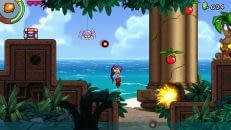Battle Fleet 2 Review – Naval Combat Simulator with Depth | Indie Game Magazine
Today, Capital J Media released the sequel to their hit game, Battle Fleet, a turn-based naval combat simulator. Set in the Pacific Theater during World War II, Battle Fleet 2 give players the chance to combat the computer or friends using different types of ships from the war, each with a wide variety of weapons and possible actions.
The core of the gameplay for Battle Fleet 2 is the turn-based naval combat system. Each battle is split into separate turns for each individual ship participating in the battle. The order of these turns depends on the experience level of the Captain, which is dependent on the number of sunken ships and battles on record. Each turn, players can choose to move their ship, attack with any and all weapons, or both. Both are controlled similarly by choosing a direction within the 360-degree circle. The turning range depends on where the ship is facing, and the type of weapon being used; standard turrets for example, will have a wider turning range than torpedo launchers. Players must then choose the amount of power to devote to that action. More power will send the ship, or the shot, further in the chosen direction. Movement is the only option that allows for a negative power level, which represents moving the ship backward. It should also be noted that if players use a small amount of power for the ship’s movement in that turn, they can make a sharper turn.
Players can choose to move, attack, or review the stats of the current ship
As you might guess, the goal of each battle is to sink all of the enemy ships by dealing enough damage to bring their HP to zero. However, the naval simulator offers several more details and interesting features to make combat interesting. For starters, each ship is split into four different, important areas: Those areas include the Bridge, Engines, Ammunition, and Rudder. If any of these areas are destroyed by a single shot, the ship may still float, but it will be severely crippled by the damage. Without an engine or a rudder, the ship will simply float in the ocean like a sitting duck, or be forced to move in a straight line. If the bridge is destroyed, the ship will lose a turn as it recovers it’s chain of command, and losing ammunition limits the total number of shots.
There are also different available weapons for each ship, different ships to choose from, and a few random power ups that can be picked up during battle. The list of weapons is short but varied in their ranges and powers. Turrets provide long range attacks with relatively medium to low damage, and can be inaccurate. Torpedoes are simple to use and aim with and do a lot of damage but have a short range that requires ships to get in close. Carriers allow players to call in air strikes using their fighter-bombers, which can provide multiple damaging hits from any range, as long as the enemy ship is visible. In the event that the ship is hidden by a fog of war, some ships can also use planes to provide recon over an area of the map. Ships can also carry Anti-Aircraft cannons that automatically fire when an air strike is occurring against the ship, or nearby. The inclusion of power cards provides an added level of strategy, as these grant special abilities such as increased range, creating a minefield in a specific area, or even providing immediate repairs.
The types of ships include Frigates, Destroyers, Cruisers, Battleships, and Carriers. The bigger ships are more expensive and require more prestige to purchase, but also tend to have a wider array of available weapons or special abilities that can offer an advantage in battle. Unfortunately, to my disappointment, the list of ships does not include the submarine. This is unfortunate, since Battle Fleet 2 would only benefit further from the further strategic depth provided by this unique ship.
Battle Fleet 2 offers a few different game modes for single player, they include Custom Battle, Quick Battle, and Campaign. Custom and quick battles put players right into the action of a single naval battle. For both modes, players choose the number of prestige points to determine the size and strength of each fleet. Higher numbers will not only mean more ships, but a more powerful ship as well, such as a Battleship or a Carrier. Players can also determine what map to do battle in, which range from the Pacific Ocean with no obstacles, to key naval battle and strategic areas of the war, such as Okinawa, Wake Island, and Midway. Different features and land masses can block lines of sight, effectively hiding enemy ships from view without a recon aircraft. Custom battles incorporate this, but also allow players to choose what types of ship will make up their fleet, and can edit the weapons configuration of their ship. Custom battle also allows players to choose the Captain for each ship by offering a pool of experience. Captains with more experience will allow the ship to take a turn sooner in the lineup.
Ships can have a different configuration of weapons to suit the player’s strategic needs
Campaign mode is a longer game that puts players in charge of the United States or Japanese Navy during the Pacific Theater of the second World War. Players will need to build and manage their fleet while protecting and expanding their territories. Campaign mode requires many battles, and provides a macro-managing element to the game.
Battle Fleet 2 also offers a multiplayer option that allows for a wider variety of intense gameplay. This is the mode of gameplay that Capital J Media is most excited for, since players can improve quickly in the midst of battle, and strategies can shift and adapt instantly. These battles are generally exciting, and depending on the layout of each fleet, very close. I was able to play in a match in which both fleets had a Battleship and a number of smaller ships to provide firepower. The battle got close, and both battleships were eventually sunk. I lost, but it was a really intense match.
The graphics for the game are impressive, and are a vast improvement over the game’s predecessor. The visuals allow for a detailed look at the moving waves in the ocean, and the intricate details of each ship. The ship will even show superficial damage as it takes more damage, or when a turret or important area is destroyed by a direct hit. This level of detail makes it feel like even attacks that don’t hit any major areas of a ship are causing an effect.
Battle Fleet 2‘s soundtrack provides a dramatic military theme that fits easily with the naval combat and the World War II setting. Now there isn’t a lot of variety within this soundtrack, so it will feel repetitive to those players who don’t get hooked into the epic drama of this style of slow-moving, strategic gameplay.
Matches can go for a long time. A decent battle between 10 or more ships can easily take up to an hour. The campaign mode is significantly longer, and tends to move at a slower pace. There’s quite a bit of replay value though, as there are a significant number of different fleet combinations and weapon configurations that players can try out. Different maps and enemy fleet formations will also require varied strategies, so every game tends to feel different. This is especially true for multiplayer matches, where different opponents will encounter new and unexpected strategies, and test their mettle against each other.
Battle Fleet 2 is a lot of fun to play, and the controls are easy to use and get used to. There is a bit of a learning curve when it comes to accurately guessing the right amount of power needed to hit a target, but the game also provides a helpful tool for this. Each ship, when players decide it’s time to attack, will be surrounded by two circles, one that reaches the maximum range of the weapon, and one that reaches the center range. Multiplayer can also be tweaked to provide a standard range of 2000, which appears no matter what weapon is chosen.
The experience provides a lot of innovation to an old genre of gameplay that some might not even remember. Compared to the old Tanks game, Battle Fleet 2 incorporates different weaponry, movement, obstacles for cannons and line of sight, key areas on each ship, and a large degree of customization. This provides players with all the pieces needed to develop many different strategies to implement in different combat scenarios.
The game is available for iOS and Android mobile devices for $4.99, and also Mac and PC for $9.99. The price point is worth the buy, especially for those who have friends who are similarly interested in playing Battle Fleet 2. Matches with the same person will likely never turn out the same way, giving this game a great deal of depth and long-lasting potential.






